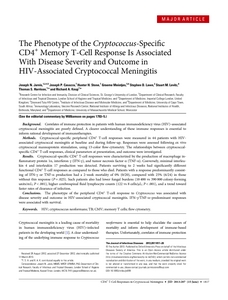Jarvis, JN; Casazza, JP; Stone, HH; Meintjes, G; Lawn, SD; Levitz, SM; Harrison, TS; Koup, RA
(2013)
The phenotype of the Cryptococcus-specific CD4+ memory T-cell response is associated with disease severity and outcome in HIV-associated cryptococcal meningitis.
The Journal of Infectious Diseases, 207 (12).
pp. 1817-1828.
ISSN 1537-6613
https://doi.org/10.1093/infdis/jit099
SGUL Authors: Harrison, Thomas Stephen Jarvis, Joseph Nicholas
![[img]](https://openaccess.sgul.ac.uk/101672/1.hassmallThumbnailVersion/The_phenotype_of_Cryptococcus_specific_CD4_memory.pdf)  Preview |
|
["document_typename_application/pdf; charset=binary" not defined]
Published Version
Download (3MB)
| Preview
|
Abstract
BACKGROUND: Correlates of immune protection in patients with human immunodeficiency virus (HIV)-associated cryptococcal meningitis are poorly defined. A clearer understanding of these immune responses is essential to inform rational development of immunotherapies.
METHODS: Cryptococcal-specific peripheral CD4(+) T-cell responses were measured in 44 patients with HIV-associated cryptococcal meningitis at baseline and during follow-up. Responses were assessed following ex vivo cryptococcal mannoprotein stimulation, using 13-color flow-cytometry. The relationships between cryptococcal-specific CD4(+) T-cell responses, clinical parameters at presentation, and outcome were investigated.
RESULTS: Cryptococcal-specific CD4(+) T-cell responses were characterized by the production of macrophage inflammatory protein 1α, interferon γ (IFN-γ), and tumor necrosis factor α (TNF-α). Conversely, minimal interleukin 4 and interleukin 17 production was detected. Patients surviving to 2 weeks had significantly different functional CD4(+) T-cell responses as compared to those who died. Patients with a response predominantly consisting of IFN-γ or TNF-α production had a 2-week mortality of 0% (0/20), compared with 25% (6/24) in those without this response (P =.025). Such patients also had lower fungal burdens (10 400 vs 390 000 colony-forming units/mL; P <.001), higher cerebrospinal fluid lymphocyte counts (122 vs 8 cells/μL; P <.001), and a trend toward faster rates of clearance of infection.
CONCLUSIONS: The phenotype of the peripheral CD4(+) T-cell response to Cryptococcus was associated with disease severity and outcome in HIV-associated cryptococcal meningitis. IFN-γ/TNF-α-predominant responses were associated with survival.
| Item Type: |
Article
|
| Additional Information: |
© The Author 2013. Published by Oxford University Press on behalf of the Infectious Diseases Society of America. This is an Open Access article distributed under the terms of the Creative Commons Attribution-NonCommercial-NoDerivs licence (http://creativecommons.org/licenses/by-nc-nd/3.0/), which permits non-commercial reproduction and distribution of the work, in any medium, provided the original work is not altered or transformed in any way, and that the work properly cited. |
| Keywords: |
CMV, HIV, TB, cryptococcus neoformans, flow cytometry, memory T cells, Adult, Antigens, Fungal, CD4-Positive T-Lymphocytes, Cohort Studies, Cryptococcus, Cytokines, Female, Follow-Up Studies, Humans, HIV Infections, Interferon-gamma, Male, Meningitis, Cryptococcal, Phenotype, Severity of Illness Index, South Africa, T-Lymphocyte Subsets, Tumor Necrosis Factor-alpha, Viral Load, Science & Technology, Life Sciences & Biomedicine, Immunology, Infectious Diseases, Microbiology, IMMUNOLOGY, INFECTIOUS DISEASES, NECROSIS-FACTOR-ALPHA, PROTECTIVE TH1 RESPONSE, NEOFORMANS INFECTION, INTERFERON-GAMMA, PULMONARY CRYPTOCOCCOSIS, VIRULENCE FACTORS, IFN-GAMMA, IMMUNE-RESPONSES, AFFERENT PHASE, MICE, 11 Medical And Health Sciences, 06 Biological Sciences |
| SGUL Research Institute / Research Centre: |
Academic Structure > Infection and Immunity Research Institute (INII) |
| Journal or Publication Title: |
The Journal of Infectious Diseases |
| ISSN: |
1537-6613 |
| Language: |
eng |
| Dates: |
| Date | Event |
|---|
| 15 June 2013 | Published |
|
| Projects: |
| Project ID | Funder | Funder ID |
|---|
| 088590 | Wellcome Trust | UNSPECIFIED | | R01 AI025780 | NIAID NIH HHS | UNSPECIFIED | | WT081794 | Wellcome Trust | UNSPECIFIED |
|
| PubMed ID: |
23493728 |
| Web of Science ID: |
WOS:000319472200007 |
  |
Download EPMC Full text (PDF)
|
 |
Download EPMC Full text (HTML)
|
 |
Go to PubMed abstract |
| URI: |
https://openaccess.sgul.ac.uk/id/eprint/101672 |
| Publisher's version: |
https://doi.org/10.1093/infdis/jit099 |
Statistics
Item downloaded times since 12 Feb 2015.
Actions (login required)
 |
Edit Item |




